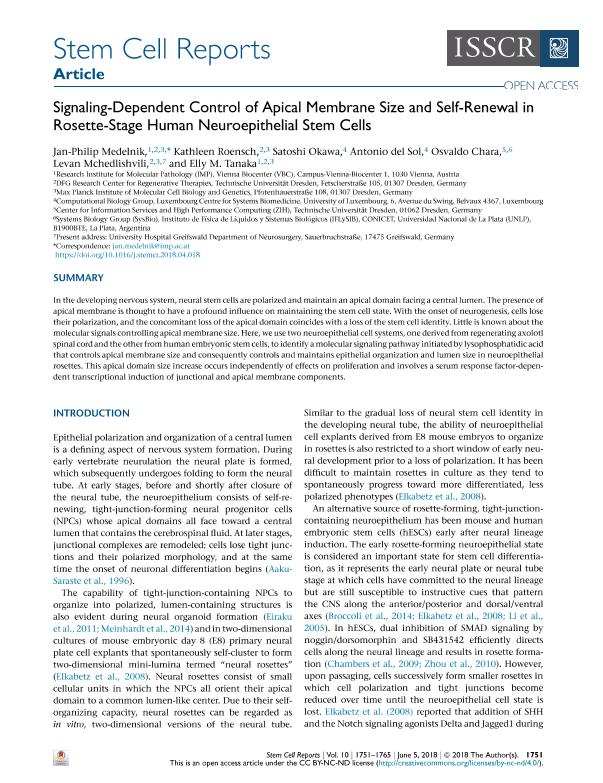Artículo
Signaling-Dependent Control of Apical Membrane Size and Self-Renewal in Rosette-Stage Human Neuroepithelial Stem Cells
Medelnik, Jan Philip; Roensch, Kathleen; Okawa, Satoshi; del Sol, Antonio; Chara, Osvaldo ; Mchedlishvili, Levan; Tanaka, Elly M.
; Mchedlishvili, Levan; Tanaka, Elly M.
 ; Mchedlishvili, Levan; Tanaka, Elly M.
; Mchedlishvili, Levan; Tanaka, Elly M.
Fecha de publicación:
06/2018
Editorial:
Cell Press
Revista:
Stem Cell Reports
ISSN:
2213-6711
Idioma:
Inglés
Tipo de recurso:
Artículo publicado
Clasificación temática:
Resumen
In the developing nervous system, neural stem cells are polarized and maintain an apical domain facing a central lumen. The presence of apical membrane is thought to have a profound influence on maintaining the stem cell state. With the onset of neurogenesis, cells lose their polarization, and the concomitant loss of the apical domain coincides with a loss of the stem cell identity. Little is known about the molecular signals controlling apical membrane size. Here, we use two neuroepithelial cell systems, one derived from regenerating axolotl spinal cord and the other from human embryonic stem cells, to identify a molecular signaling pathway initiated by lysophosphatidic acid that controls apical membrane size and consequently controls and maintains epithelial organization and lumen size in neuroepithelial rosettes. This apical domain size increase occurs independently of effects on proliferation and involves a serum response factor-dependent transcriptional induction of junctional and apical membrane components. Medelnik and colleagues identify lysophosphatidic acid as a serum factor that has a major effect on the expansion of the apical domain of human ESC-derived neural progenitor cells, resulting in the formation of very large neural rosette-like structures that can be maintained for many passages in the absence of neuronal and glial differentiation if constantly supplied with LPA.
Archivos asociados
Licencia
Identificadores
Colecciones
Articulos(IFLYSIB)
Articulos de INST.FISICA DE LIQUIDOS Y SIST.BIOLOGICOS (I)
Articulos de INST.FISICA DE LIQUIDOS Y SIST.BIOLOGICOS (I)
Citación
Medelnik, Jan Philip; Roensch, Kathleen; Okawa, Satoshi; del Sol, Antonio; Chara, Osvaldo; et al.; Signaling-Dependent Control of Apical Membrane Size and Self-Renewal in Rosette-Stage Human Neuroepithelial Stem Cells; Cell Press; Stem Cell Reports; 10; 6; 6-2018; 1751-1765
Compartir
Altmétricas



